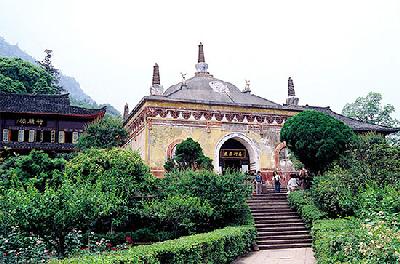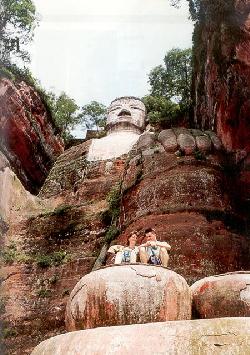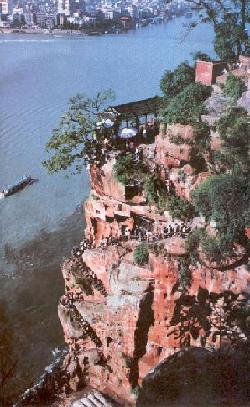Located in Sichuan Province, Emei Mountain's history has been recorded for over 2,000 years, during which time a rich Buddhist cultural heritage has accumulated. Atop the Golden Summit, which is 3,099 meters high, one can enjoy the sunrise, seas of clouds, the Buddha's halo and the sunset glow.
 |
| Wannian Temple |
Within the beamless hall of the Wannian Temple, a hall with outstanding architectural features, towers a bronze statue of Samantabhadra. Cast in 980 in the Song Dynasty (960-1279), it is 7.85 meters high, weighs 62 tons and is one of China's important cultural relics. The Baoguo Temple is the site of flourishing Buddhist activities. The Fuhu Temple, the largest temple on the mountain, is surrounded by ancient nanmu trees.
|

|
| Visitors at a toe of the Giant Buddha of Leshan,Sichuan Province |
The Leshan Giant Buddha scenic area, which covers 2.5 square kilometers, is famous for its Giant Buddha statue, said to be the biggest Buddha statue in the world. The way in which the cultural features have been integrated with the natural scenery is considered to be a precious legacy. The Giant Buddha statue, carved on the mountain, stands 71 m high, with its back against Jiuding Mountain and facing the confluence of the Minjiang, Dadu and Qingyi rivers. There are more than 90 stone carvings and Buddhist shrines on both sides of the Giant Buddha.
Other cultural artifacts include the Lidui (a large rock cut in the center of the river for irrigation purposes by Li Bing of the Qin Dynasty), Wuyou Mountain, Han tombs, Buddha statues of the Tang and Song Dynasties, and pagodas, temples and architectural complexes of the Ming and Qing dynasties (1368-1911).
Biologically, the area hosts some 5,000 plant species and 2,300 animal species. There are a number of threatened species, some being endemic to Emei Mountain.
 Cultural Heritage
Cultural Heritage
With a large number of cultural and historic relics, Emei Mountain and the Leshan Giant Buddha scenic area leave rich historic and monumental legacy. They are common heritage of the mankind.
 Natural Heritage
Natural Heritage
Emei Mountain is blessed with a world-acclaimed natural heritage. Below are details of selected items of landscape, geomorphic features, fauna and flora.
1. Major scenes
The Site contains a diverse natural environment. Along the 60 kilometers trail up to the mountain there are hundreds of natural scenic spots. Brief information of major ones is given as follows:
|
Scene
|
Location
|
Features
|
|
Palaces in Clouds
|
Golden Summit
|
Atop the Wanfoding Summit, looking east, one will enjoy the seas of clouds under blue and clear sky. The Golden Summit is just towering aloft in the clouds. Magnificent temples and other buildings can be dimly seen in the sun, just like the mysterious Buddhist palaces.
|
|
Sunrise on the Golden Summit
|
Golden Summit
|
The day is dawning. On the eastern horizon, a purple sun rises slowly. Suddenly it jumps up with all its shimmering rays. The whole mountain then is in the golden sunshine.
|
|
Leshan Giant Buddha
|
Lingyun Mountain
|
The world's highest stone statue of Maitreya is carved on the Lingyun Mountain, facing the Dadu River. Viewed from a distance, the mountain is in the figure of a Buddha while the Giant Buddha also looks like a mountain. The cultural heritage is in perfect harmony with the natural landscape.
|
|
Surging Spring
|
Maohegou Ravine
|
The spring is near Maohegou. It is too deep to be sounded, with a diameter of 4 meters at the mouth. Every noon in fine weathers, water spurs out and a colorful ring of light appears over the spring in the sunshine, moving with the surging water.
|
2. Physical features
 |
| The Nine-Twist plank trail |
The most varied topography of Emei Mountain includes a range of landscape of high peaks and deep gullies. These landscapes are direct result of special geological structure of Emei Mountain. The majority of the late Precambrian sedimentary strata are well developed. The Emei Mountain basalt of late Permian is of particular stratigraphic significance.
 Buddha's halo and Holy lights
Buddha's halo and Holy lights
1. Buddha's halo
This is a special physical phenomenon. When the sun projects the shadow of the viewer on the clouds in front of him or her, ice crystals and tiny drops of water in the clouds may reflect the light to form a rainbow around the shadow. Only in few places with appropriate sync of light, landform and clouds could the halo be enjoyed.
2. Holy lights
On evenings when the moon can not be observed (either in the early or late period of a lunar month), and after rain, tourists may see countless shining balls of light rising from the foot of the cliff and floating up in the air. This is the mysterious scene of holy lights.
